Experimental Study of the Plastic Zone and Stress Asymmetric Distribution in Roadway Layered Surrounding Rocks
Abstract
:Featured Application
Abstract
1. Research Status of the Roadway Layered Surrounding Rock Plastic Zone
2. Establishment and Simulation Analysis of the Experimental Model of Roadway Layered Surrounding Rock
2.1. Introduction of the Experimental Equipment
2.2. Production of Experimental Models
2.3. Experiment-Related Data Acquisition
2.4. Experimental Stress-Loading Scheme
3. Analysis of Simulation Results
3.1. Surface Deformation and Analysis of Roadway Surrounding Rock
3.2. Data Analysis of Surface-Surrounding Rock Deformation
4. Numerical Simulation Analysis of Roadway Layered Surrounding Rock Deformation
4.1. Numerical Model Establishment
4.2. Analysis of Simulation Results
- (1)
- Without the influence of the joint surface, the development depth of the plastic zone of the roadway roof and the two sides was the same, the development depth of the plastic zone of the roadway floor was larger, and the plastic zone was less developed at the intersection of the two sides and the floor of the roadway.
- (2)
- When there was a joint surface, the shape of the plastic zone changed, and the depth of the plastic zone increased to a certain extent at the junction of the high top and the roof and the junction of the low-cut zone and the roof, as shown in Figure 9a zone 1 and zone 2. There wass no plastic zone at the junction of the high top and the bottom plate, Figure 9a zone 3. In the roadway floor, the deepest zone of the plastic zone moved to the lower side of the roadway, Figure 9a zone 4. Under the influence of joints, in the junction of the lower side and the floor of the roadway, there was still a blind area for the development of the plastic zone, as shown in Figure 9a zone 5.
5. Conclusions
- (1)
- The deformation of the surrounding rock in roadway layered surrounding rock was asynchronous in time and asymmetric in space. The temporal asynchrony manifested in the order of appearance of the deformation area of the roadway surrounding rock, showing that the tangent area between the layered surrounding rock and the roadway surface was the earliest, followed by the layered surrounding rock and the vertical area of the roadway surface. The spatially asymmetric deformation of the surrounding rock of the layered roadway manifested in that the deformation amount was different in different areas of the surrounding rock of the roadway. The order of the displacement of surrounding rock at the four corners of the roadway was upper right, lower left, upper left, and lower right.
- (2)
- The layered surrounding rock conditions affected the shape symmetry of the plastic zone of the roadway. The specific performance was that in the area where the rock layer and the roadway surface were tangent, and in the vertical area between the rock layer and the roadway surface, the plastic zone had a large development depth, while other areas had a small plastic zone development depth, and there was a blind zone in the lower right area.
- (3)
- Affected by the development shape of the layered surrounding rock and the plastic zone, the internal stress value of the surrounding rock at the same distance from the roadway surface was different. With the increase of the surrounding rock stress, the plastic zone inside the surrounding rock of the roadway expanded, and the stress at the stress monitoring point first increased and then decreased; the perpendicular radial stress inside the surrounding rock of the roadway was smaller than the tangential stress.
- (4)
- Similar simulation stress monitoring results and numerical simulation plastic zone distribution showed that the stress monitoring value increased with an increase of the model’s confining pressure when monitoring points were outside the plastic zone. With the plastic zone expanding, the monitoring points which closer to the roadway surface moved from outside of the plastic zone into the plastic zone, and the monitoring points’ stress value first increased and then decreased.
- (5)
- From the point of view of the arrangement direction of the pressure box at the monitoring point, on the same radius from the center of the roadway, if the normal direction of the pressure box was tangent to the concentric circle of the roadway, the stress value of the monitoring point increased greatly, and if it was vertical, the stress value increased more slowly.
Author Contributions
Funding
Institutional Review Board Statement
Informed Consent Statement
Data Availability Statement
Conflicts of Interest
References
- Li, G.C.; Zhang, N.; Wang, C.; Zhang, N.C.; Li, B.Y. Optimizing the Section Shape of Roadways in High-Stress Ground by Numerical Simulation. J. China Univ. Min. Technol. 2010, 39, 652–658. (In Chinese) [Google Scholar]
- Jia, H.; Ma, N.; Zhu, Q. Mechanism and control method of roof fall resulted from butterfly plastic zone penetration. J. China Coal Soc. 2016, 41, 1384–1392. (In Chinese) [Google Scholar]
- Ma, N.J.; Guo, X.F.; Zhao, Z.Q.; Zhao, X.D.; Liu, H.T. Occurrence mechanisms and judging criterion on circular tunnel butterfly rockburst inhomogeneous medium. J. China Coal Soc. 2016, 41, 2679–2688. (In Chinese) [Google Scholar]
- Li, J.; Ma, N.; Zhao, Z. Butterfly leaf type roof falling mechanism and control technology of mining gateway. J. China Coal Soc. 2017, 45, 46–52. (In Chinese) [Google Scholar]
- Liu, H.; Wu, X.; Hao, Z.; Zhao, X.; Guo, X. Evolution law and stability control of plastic zones of retained entry of working face with double roadways layout. J. Min. Saf. Eng. 2017, 34, 689–697. (In Chinese) [Google Scholar]
- Li, L.; Tan, Z. Characteristic and mechanism research for large deformation problem in squeezing-shattered soft rock tunnel. Chin. J. Rock Mech. Eng. 2018, 37, 3593–3603. (In Chinese) [Google Scholar]
- Liu, G.; Xiao, Y.; Zhu, J.; Jing, H. Overview of the theoretical calculation method of broken rock zone. J. China Coal Soc. 2021, 46, 46–56. (In Chinese) [Google Scholar]
- Wang, W.J.; Guo, G.Y.; Zhu, Y.J.; Yu, W. Malignant development process of the plastic zone and control technology of high stress and soft rock roadway. J. China Coal Soc. 2015, 40, 2747–2754. (In Chinese) [Google Scholar]
- Yue, Y.; Weijun, W.; Chao, Y.; Weijian, Y.; Hai, W.; Wenqing, P. Large deformation failure mechanism of surrounding rock for gate road under dynamic pressure in deep coal mine. J. China Coal Soc. 2016, 41, 2940–2950. (In Chinese) [Google Scholar]
- Wang, W.; Dong, E.; Yuan, C. Boundary equation of plastic zone of circular roadway in non-axisymmetric stress and its application. J. China Coal Soc. 2019, 44, 105–114. (In Chinese) [Google Scholar]
- Zhang, S.; Wang, X.; Jia, Z.; Ju, S. Study on application of asymmetrical support technology to mine roadway with multi-layer inclined rock strata. Coal Sci. Technol. 2018, 46, 74–80. (In Chinese) [Google Scholar]
- Shao, S.; Huang, Q.; Zhang, Q.; Ma, K.; Zhao, M. Study on Outward Sliding Mechanism of Roadway in Mudstone Interlayers Coal Seam and Support Method. Coal Sci. Technol. 2014, 42, 124–128. (In Chinese) [Google Scholar]
- Yu, Y.; Bo, J.; Wang, X.; Shen, W.; Lian, C. Study on asymmetric distortion and failure characteristics and stability control of soft rock roadway. J. Min. Saf. Eng. 2014, 31, 340–346. (In Chinese) [Google Scholar]
- Zhao, Z. Mechanism of Surrounding Rock Deformation and Failure and Control Method Research in Large Deformation Mining Roadway. Ph.D. Thesis, China University of Mining, Beijing, China, 2014. (In Chinese). [Google Scholar]
- Zhao, Z.Q.; Ma, N.J.; Liu, H.; Guo, X.F. A butterfly failure theory of rock mass around roadway and its application prospect. J. China Univ. Min. Technol. 2018, 47, 969–978. (In Chinese) [Google Scholar]
- Yang, F.; Chen, W.; Zheng, P.Q. Research on mechanism of deformation and failure for steeply inclined roadways in soft-hard alternant strata and its support technology. Rock Soil Mech. 2014, 35, 2367–2374. (In Chinese) [Google Scholar]
- Chen, J.; Yan, R.; Liu, K. Asymmetric deformation mechanism of the roadway at steeply inclined thick coal seam. J. China Coal Soc. 2018, 43, 3007–3015. (In Chinese) [Google Scholar]
- Ma, T.; Li, S.; Xu, X. Model experimental study of deformation and failure law in excavation of deep rock mass with multi-cleftiness of different angles. Rock Soil Mech. 2016, 37, 2899–2908. (In Chinese) [Google Scholar]
- Yin, G.; Lu, J.; Li, X. Stability and plastic zone characteristics of surrounding rock under true triaxial stress conditions. J. China Coal Soc. 2018, 43, 2709–2717. (In Chinese) [Google Scholar]
- Yaylaci, M. Simulate of edge and an internal crack problem and estimation of stress intensity factor through finite element method. Adv. Nano Res. 2022, 12, 405–414. [Google Scholar] [CrossRef]
- Öner, E.; Şabano, B.Ş.; Yaylacı, E.U.; Adıyaman, G.; Yaylacı, M.; Birinci, A. On the plane receding contact between two functionally graded layers using computational, finite element and artificial neural network methods. Z. Angew. Math. Mech. 2022, 102, e202100287. [Google Scholar] [CrossRef]
- Murat, Y.; Mujgen, Y.; Uzun, Y.E.; Hasan, O.; Ahmet, B. Analyzing the contact problem of a functionally graded layer resting on an elastic half plane with theory of elasticity, finite element method and multilayer perceptron. Struct. Eng. Mech. 2021, 78, 585–597. [Google Scholar] [CrossRef]
- Yaylaci, M.; Sabano, B.S.; Ozdemir, M.E.; Birinci, A. Solving the contact problem of functionally graded layers resting on a HP and pressed with a uniformly distributed load by analytical and numerical methods. Struct. Eng. Mech. 2022, 82, 401–416. [Google Scholar] [CrossRef]
- Wu, H.; Jia, Q.; Wang, W.; Zhong, N.; Zhao, Y. Experimental Test on Nonuniform Deformation in the Tilted Strata of a Deep Coal Mine. Sustainability 2021, 13, 13280. [Google Scholar] [CrossRef]
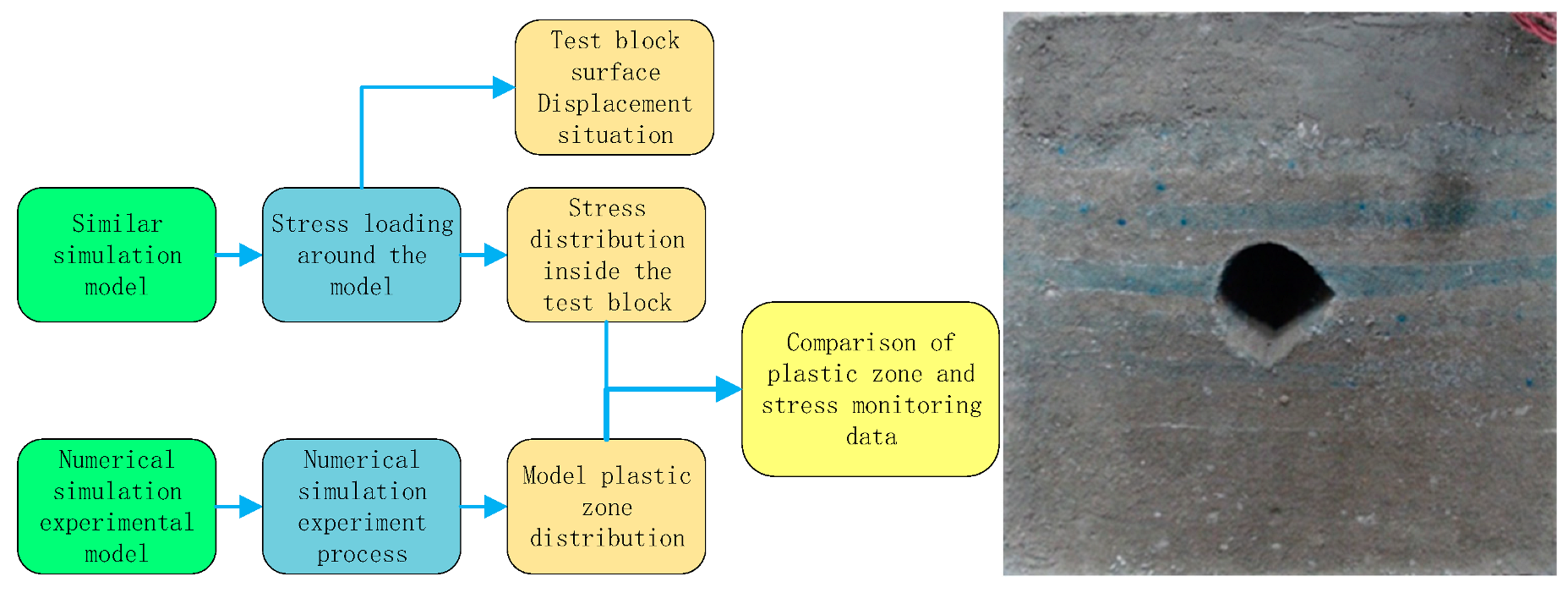
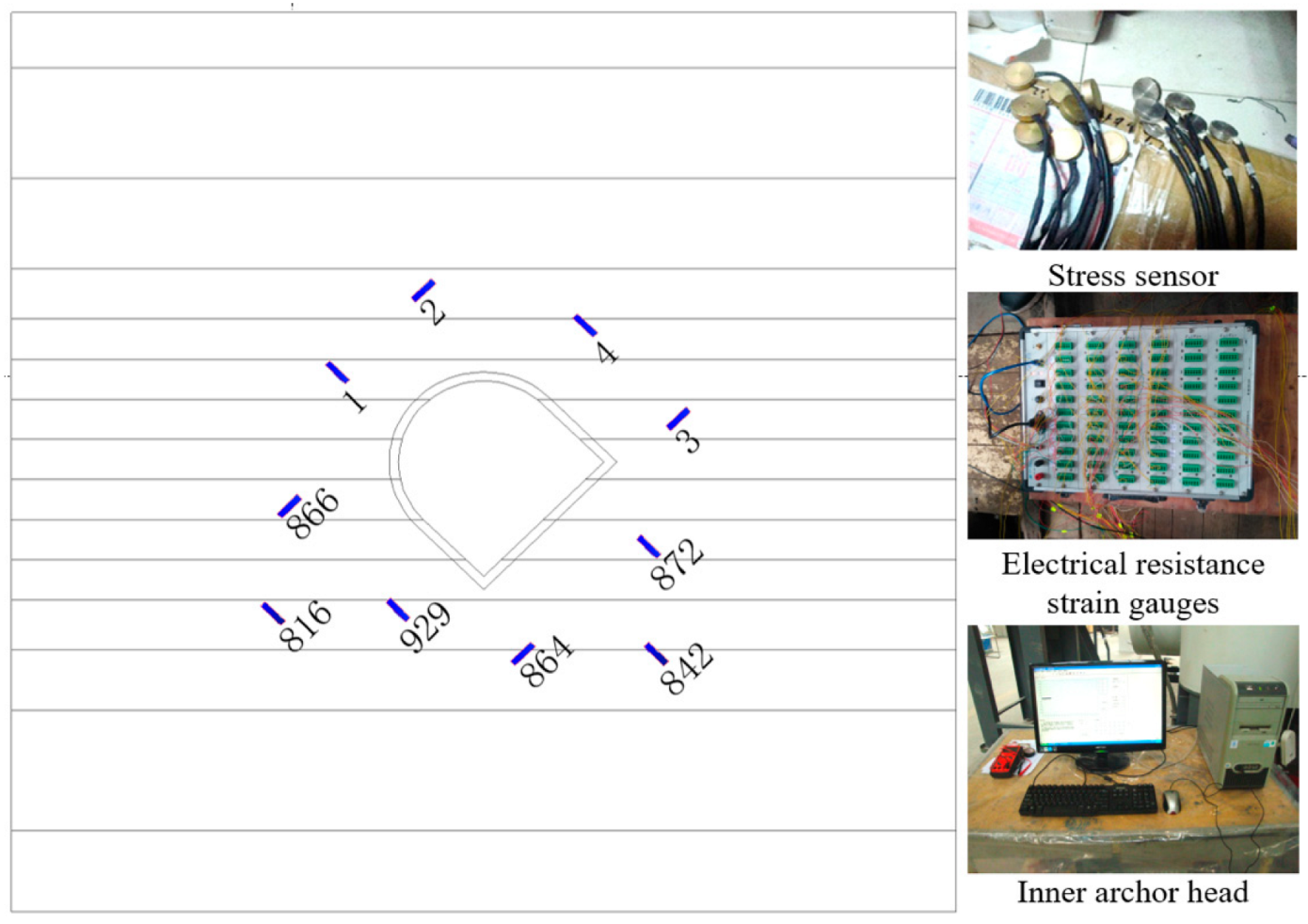
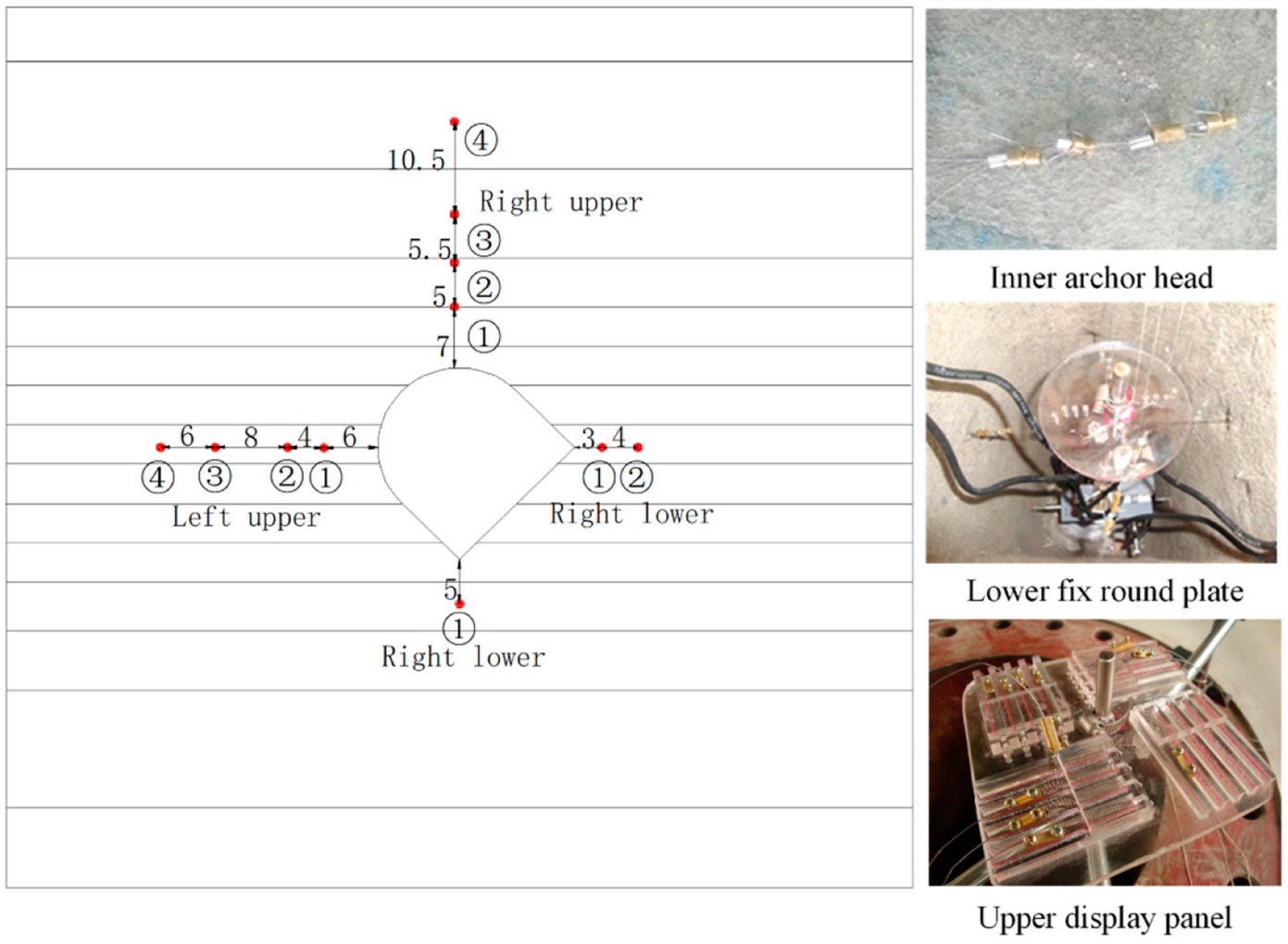
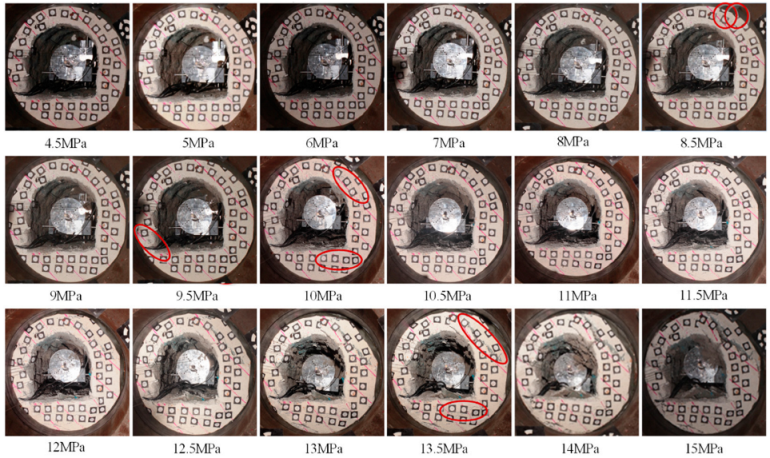
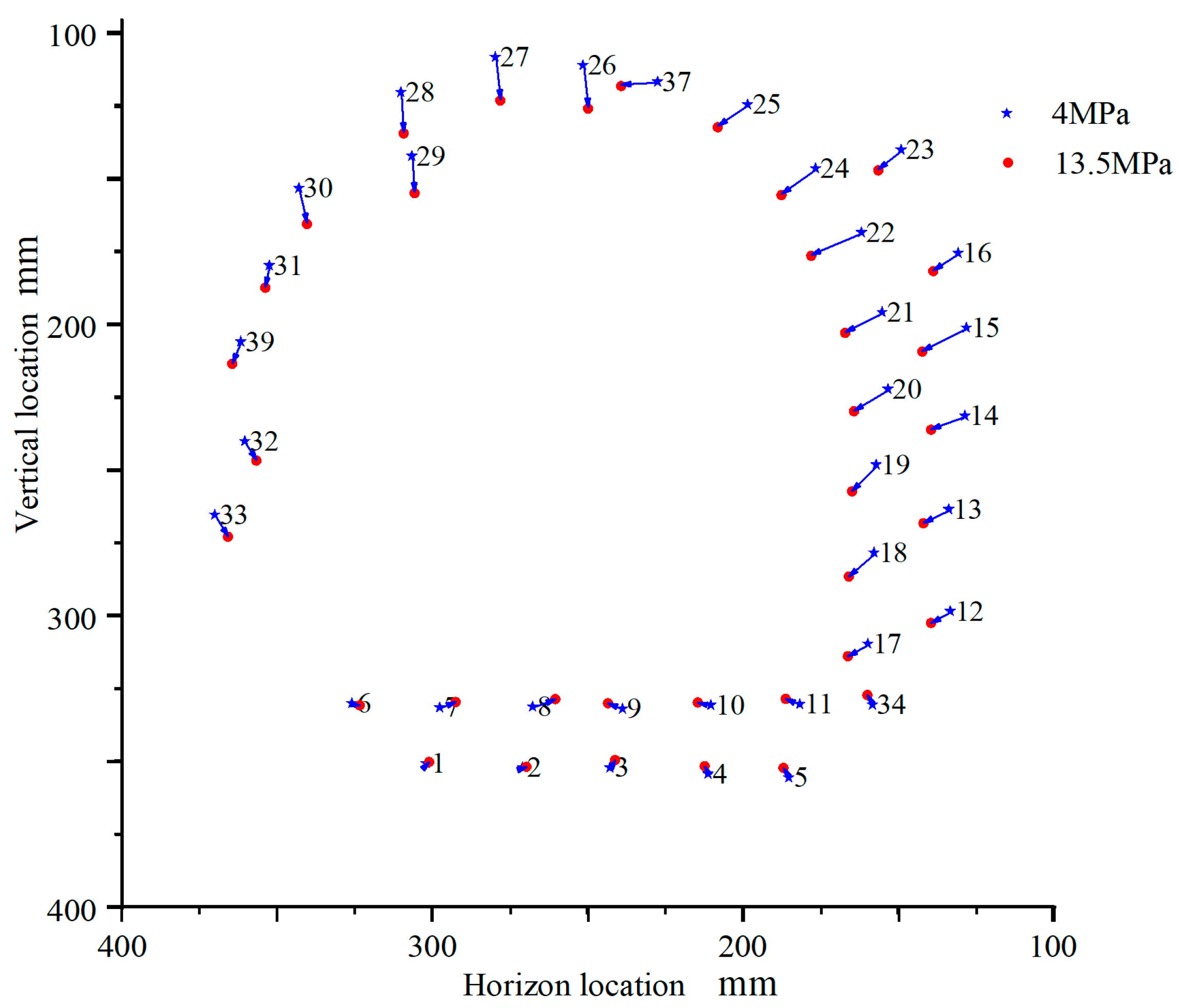
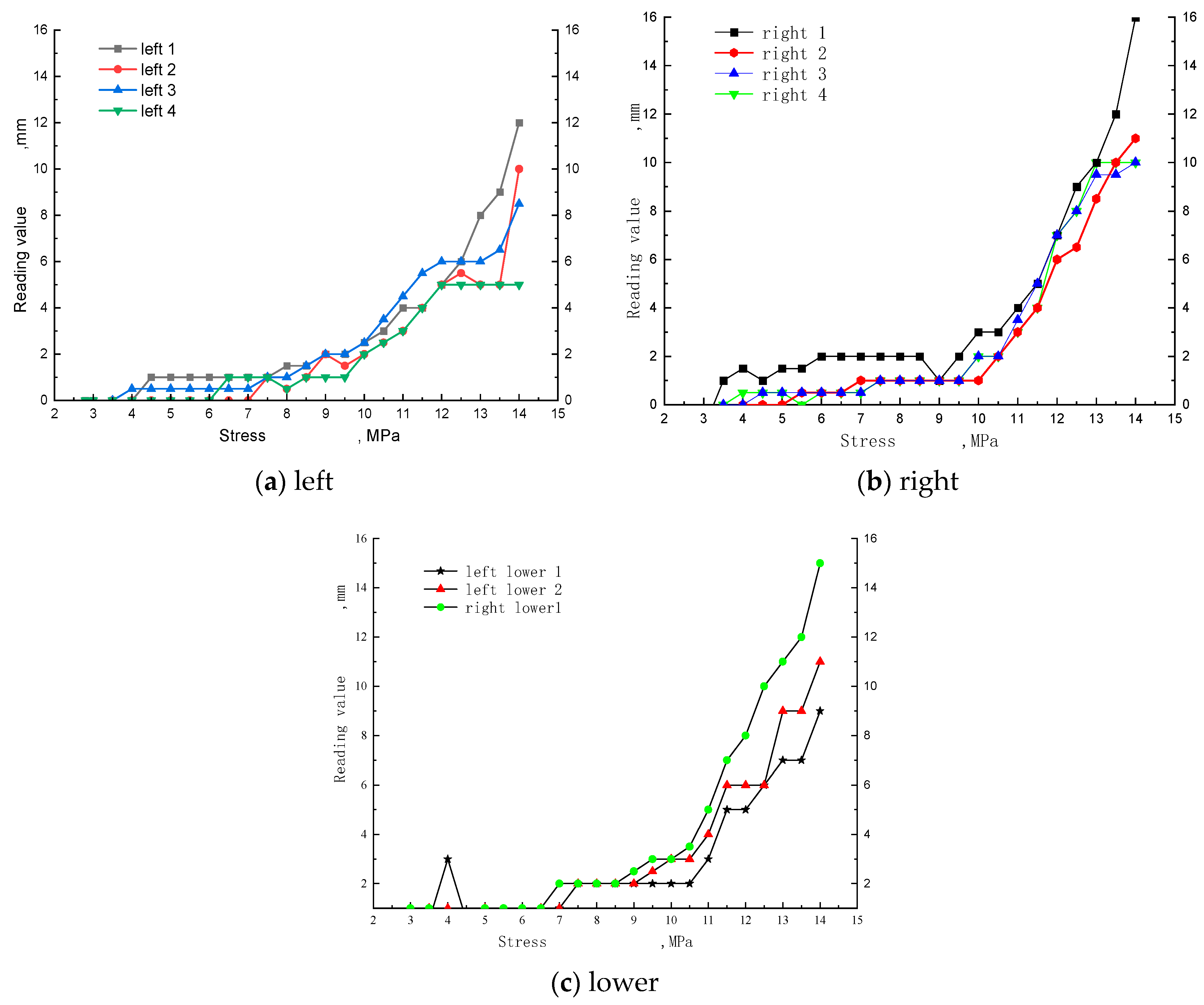
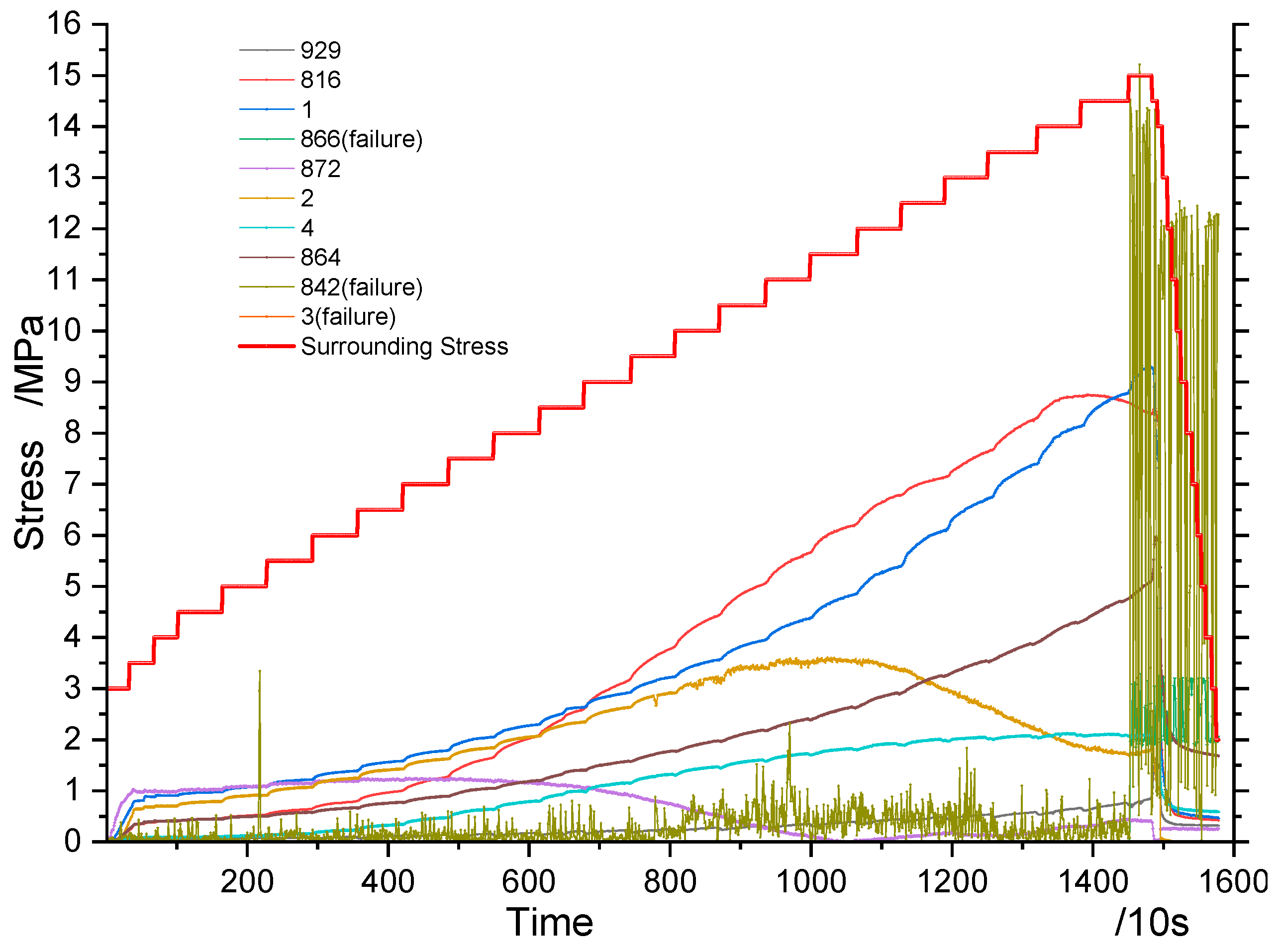

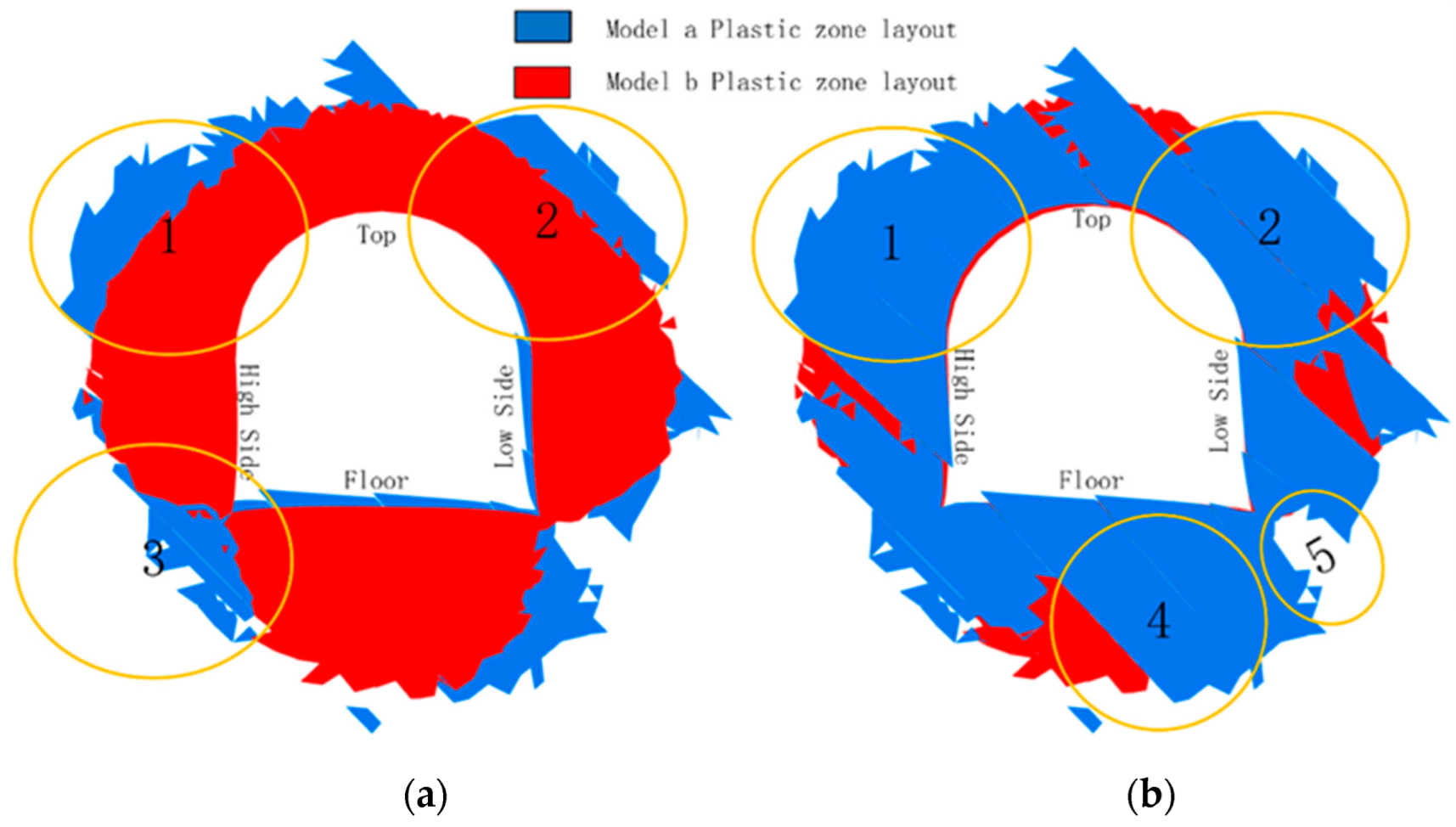

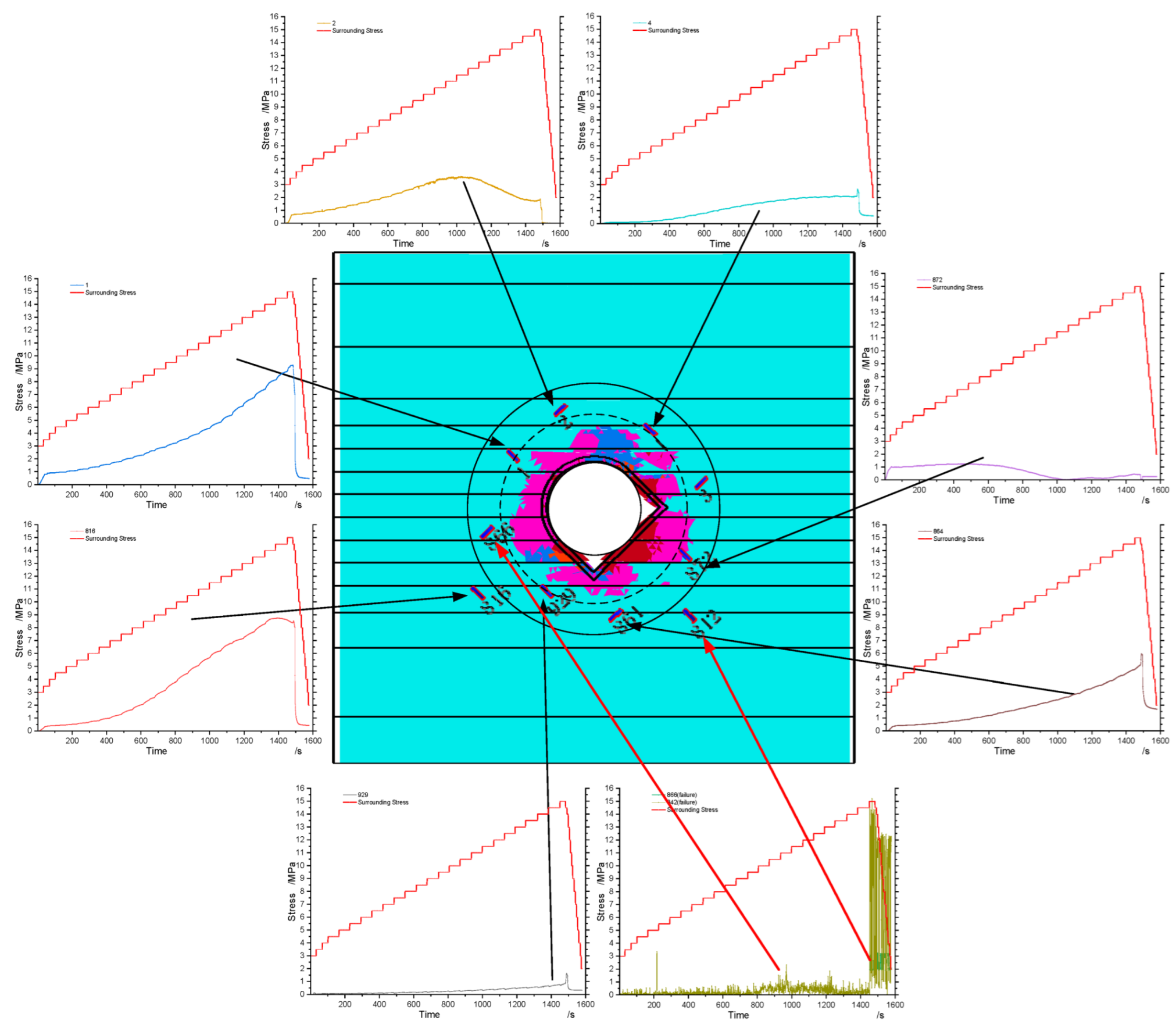
Publisher’s Note: MDPI stays neutral with regard to jurisdictional claims in published maps and institutional affiliations. |
© 2022 by the authors. Licensee MDPI, Basel, Switzerland. This article is an open access article distributed under the terms and conditions of the Creative Commons Attribution (CC BY) license (https://creativecommons.org/licenses/by/4.0/).
Share and Cite
Chen, J.; Wu, H.; Zhang, X.; Gao, X.; Ling, T.; Zhang, Z. Experimental Study of the Plastic Zone and Stress Asymmetric Distribution in Roadway Layered Surrounding Rocks. Appl. Sci. 2022, 12, 6108. https://doi.org/10.3390/app12126108
Chen J, Wu H, Zhang X, Gao X, Ling T, Zhang Z. Experimental Study of the Plastic Zone and Stress Asymmetric Distribution in Roadway Layered Surrounding Rocks. Applied Sciences. 2022; 12(12):6108. https://doi.org/10.3390/app12126108
Chicago/Turabian StyleChen, Jiaren, Hai Wu, Xuan Zhang, Xu Gao, Tao Ling, and Zizheng Zhang. 2022. "Experimental Study of the Plastic Zone and Stress Asymmetric Distribution in Roadway Layered Surrounding Rocks" Applied Sciences 12, no. 12: 6108. https://doi.org/10.3390/app12126108






